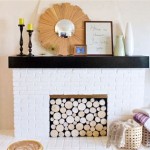Painting the Interior of an Unused Fireplace: A Comprehensive Guide
An unused fireplace can often become an unsightly focal point within a room. Instead of serving as a source of warmth and ambiance, it can appear dark, dusty, and simply outdated. One effective solution to revitalize this space is to paint the interior. Painting can transform the fireplace from an ignored relic to a stylish architectural feature, harmonizing with the overall aesthetic of the room. However, the process requires careful preparation and execution to achieve a lasting and visually appealing result.
Before even considering paint colors, it is crucial to assess the condition of the fireplace. Years of soot buildup, potential water damage, and the composition of the interior material all influence the preparation steps needed for a successful paint job. Ignoring these factors can lead to peeling paint, poor adhesion, and ultimately, wasted time and resources.
Key Considerations Before Painting
The first and perhaps most important step is thorough cleaning. Over time, fireplaces accumulate significant amounts of soot and creosote. These substances are not only unsightly but can also prevent paint from properly adhering to the surface. Using a wire brush, a shop vacuum, and a specialized fireplace cleaner are essential for removing this buildup. It is imperative to wear appropriate safety gear, including gloves, a mask, and eye protection, during this process.
The material of the fireplace interior dictates the type of paint and primer that should be used. Common materials include brick, stone, and metal. Brick and stone are porous and require a masonry primer to seal the surface and prevent the paint from being absorbed. Metal fireplaces require a rust-inhibiting primer to prevent corrosion. Identifying the material is crucial to choosing the correct products for optimal adhesion and longevity.
Finally, consider the overall design of the room and the desired aesthetic. Dark colors can create a dramatic effect and visually recede into the background, while lighter colors can brighten the space and make the fireplace appear larger. Matte finishes tend to conceal imperfections, while gloss finishes are easier to clean. The choice of color and finish should complement the existing décor and achieve the desired ambiance.
Step-by-Step Painting Process
Once the fireplace has been thoroughly cleaned and inspected, the next step is to prepare the surrounding area. Cover the floor and any nearby walls with drop cloths or plastic sheeting to protect them from paint splatters. Use painter's tape to mask off any areas that should not be painted, such as the fireplace surround or mantel.
Priming is a critical step for ensuring proper paint adhesion and a uniform finish. Apply the appropriate primer based on the fireplace material, using a brush or roller. Allow the primer to dry completely according to the manufacturer's instructions. This typically requires several hours or even overnight. A well-primed surface will provide a solid foundation for the paint and prevent it from being absorbed into the porous materials.
After the primer has dried, apply the first coat of paint. Use a high-quality paint specifically designed for fireplace interiors. These paints are typically heat-resistant and non-toxic. Apply the paint in thin, even coats, using a brush or roller. Allow the first coat to dry completely before applying a second coat. Two coats of paint are usually sufficient for achieving full coverage and a durable finish.
Choosing the Right Paint and Primer
Selecting the appropriate paint and primer is paramount to the success of the project. For brick and stone fireplaces, a masonry primer is essential. This primer seals the porous surface and prevents the paint from being absorbed, ensuring a uniform finish and preventing the paint from peeling or cracking over time. Choose a primer specifically designed for interior masonry surfaces.
When painting a metal fireplace, a rust-inhibiting primer is necessary. This primer protects the metal from corrosion and provides a smooth surface for the paint to adhere to. Ensure that the chosen primer is compatible with the type of metal used in the fireplace construction. Galvanized metal, for example, requires a specialized primer to ensure proper adhesion.
The choice of paint should be based on its heat resistance and its ability to withstand the harsh environment of a fireplace. High-heat paints, often used for grills or stoves, are suitable for fireplace interiors. These paints are designed to withstand high temperatures without blistering, peeling, or emitting harmful fumes. Choose a paint that is specifically labeled for use in fireplaces or stoves.
Finally, consider the finish of the paint. Matte finishes tend to conceal imperfections and create a more subtle look. Semi-gloss finishes are more durable and easier to clean. Gloss finishes are the most durable and easiest to clean, but they can also highlight imperfections. The choice of finish depends on the desired aesthetic and the level of maintenance required.
By carefully considering these factors and following the steps outlined, it's possible to transform an unused fireplace into a beautiful and functional architectural element that enhances the overall aesthetic of the room. Remember that patience and attention to detail are crucial for achieving a professional-looking result.

Get Creative With Your Empty Fireplace

16 Empty Fireplace Ideas How To Style A Non Working

Pin On Home Decor

Top Tips On How To Decorate An Unused Fireplace

Styling The Unused Fireplace My Manicured Life

Paint The Inside Of Your Fireplace And Change Grout Color

How To Decorate An Unused Fireplace Panadero

7 Unique Ways To Remodel Decorate Your Unused Fireplace

Decorating Your Unused Fireplace Remodel Fort Collins Co

7 Awesome Ideas For An Unused Fireplace White Home Decor
Related Posts








